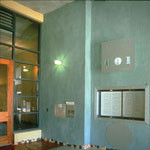Community
For Holliday Development, community development and real estate development go hand-in-hand. Our projects have a long term impact in the communities that we work with, and we always engage with the community as partners to make our developments as meaningful and successful as possible. Starting in South of Market over 20 years ago, Holliday Development has been pioneering in neighborhoods throughout the Bay Area, including Potrero Hill, Emeryville, and West Oakland.
Today, it is difficult to imagine South of Market nearly empty and abandoned like it was 20 years ago when Holliday introduced the first live-work lofts. Or in West Oakland, where a survey was done that showed the closer residents were to the proposed development and the longer they had been in the neighborhood, the more they supported our work. We don’t just build buildings; we support local nonprofits, entrepreneurs, and first time homebuyers throughout the community to lay a strong foundation for the future.
-
Bayview

In 2008, as a deepening recession had wrecked havoc on new developments and established neighborhoods across the country, Holliday Development was approached by lenders who had been impressed with our resolve in other challenging neighborhoods to take over two important projects in San Francisco’s Bayview neighborhood that had been severely derailed, and put them back on track for the good of the local community. A prior developer had made big promises to the neighbors in the bubble of a few years ago, but left them with deep wounds and half-built scars on the landscape. Holliday understood that by working with local leaders and redesigning the projects so that they could be completed within the limited remaining budget, there was still a way to bring the buildings to market and benefit the neighborhood. The results are San Francisco’s nicest affordable rental housing project, and an outstanding example of mixed income and mixed use development that brought a fresh food grocer and small locally-owned restaurants, a senior center, and high quality housing targeted to workforce renters and homeowners to the Bayview.
-
West Oakland

Holliday Development has long been a pioneer in transforming neighborhoods. Before Holliday Development built Central Station, West Oakland had a storied history but a troubled recent past. When Rick Holliday saw the opportunity to turn the abandoned historic 16th Street Train Station into a community asset, and the land around it into a catalyst for positive change, the local community embraced the idea of bringing new life to the neighborhood. 29 acres of former railyard is now occupied by the first 400 of 1200 homes to be built in Central Station. These 400 units include the 163 unit Pacific Cannery Lofts, where young technology workers from Apple, Google, and Genentech, professional photographers and architects, and young working professional families have bought their first homes, and some long-ago West Oakland residents who moved away have come back to reinvest. The residents have gotten involved in neighborhood clean-ups, crime prevention, planning, and other efforts to continue the transformation and rejuvenation of this great neighborhood.
-
SOMA

The Holliday Development story began in SoMa in the late 1980s. Holliday Development’s first three projects The Clocktower Lofts, 355 Bryant, and 601 4th, brought a new type of housing to the San Francisco market – live/work lofts – that met the need of an emerging economy of professionals who worked from home but embodied a big change in the global economy. “White Collar Live Work” as it was called was different from the Bohemian live/work lifestyle of New York artists because it was creative professionals who ran a small boutique service business, or incubated an early tech start-up, that would grow into drivers of San Francisco’s 21st century economy. Today, these are SOMA landmarks, and perhaps some of San Francisco’s most coveted addresses both for tech start-up offices and innovative individual’s homes because of the legacy of the creativity and community that developed in these first live/work buildings in SOMA.
-
Truckee

Truckee is Tahoe’s most diverse and complete year-round community. It is home to much of the Tahoe area workforce, an outstanding regional hospital, and great small businesses, artists, and outdoor fanatics of all ages who have made Tahoe home. The Town was first founded as a hub of the mining and railroad community, and was incorporated in 1993 when the community organized to fight the County’s lax land use regulation which was turning the beautiful town into a sea of sprawling subdivisions and big box chain retail. That community organization and identity resulted in a strong sense of ownership and participation in the Truckee Railyard Master Plan development process. Holliday Development partnered with the Town to work with the community to define a clear vision for the future of the place they call home. Today, town members are excited for the possibility to bring movie and preforming arts theaters for performing arts groups and community events, space for thriving local businesses to grow into, and new homes for future members of their soccer leagues, classes, and clubs to the downtown on the Railyard.
-
Emeryville

Holliday Development was attracted to Emeryville as the economic engine of the East Bay – home of Pixar, Peet’s Coffee, and some of the world’s most innovative pharmaceutical and bio-engineering companies. The Emeryville Warehouse lofts and Blue Star Corner, as well as future projects in the works, offer great flexible space for professionals to build a business or a family, and meet their neighbors in unique community gathering spaces. Whether at Emeryville Warehouse’s street front lofts with roll-up doors that make it easy to open for business as a hair salon or architecture firm, or on the rooftop deck with panoramic views of the Bay and East Bay Hills, the buildings are designed to foster interaction between the people who live there and have created the strongest economy and increasingly dynamic community of the East Bay.



















